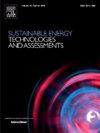Reconstructing the upwind field of wind turbines using LiDAR data
IF 7.1
2区 工程技术
Q1 ENERGY & FUELS
Sustainable Energy Technologies and Assessments
Pub Date : 2025-06-03
DOI:10.1016/j.seta.2025.104382
引用次数: 0
Abstract
With the growing demand for renewable energy, optimizing wind turbine performance requires accurate understanding of upstream wind flow. This study introduces a model for characterizing upwind flow using two years of raw radial wind speed (RWS) data from a fixed 4-beam nacelle-mounted LiDAR system. The model incorporates axial and lateral wind speed components, wind shear exponent (WSE), veer, and wind turbine induction factor. These parameters are optimized by minimizing the mean absolute error (MAE) using stochastic gradient descent and the Adam optimization algorithm. Hypothesis testing for linear veer profiles, power law shear, and induction zone models demonstrated statistical significance at the 95 % confidence level in 99 %, 90 %, and 92 % of cases, respectively. The model achieved an MAE of 0.08 m/s (1.3 %) for reconstructing horizontal RWS. Notable diurnal variations were observed in model parameters; at night, when the atmospheric boundary layer (ABL) is stable, WSE, veer, and axial wind speed components increase, while during the day, ABL instability leads to higher turbulence intensity. The model’s short optimization duration (0.25 s) makes it suitable for real-time applications in wind turbine control, such as alignment and yaw control for wake steering strategies using nacelle-mounted LiDAR.
利用激光雷达数据重建风力涡轮机的逆风场
随着对可再生能源的需求不断增长,优化风力涡轮机的性能需要准确了解上游的风流。本研究介绍了一个模型,该模型使用了固定的四束吊舱安装的激光雷达系统两年的原始径向风速(RWS)数据来表征逆风流。该模型包含了轴向和侧向风速分量、风切变指数(WSE)、转向和风力机感应系数。采用随机梯度下降法和Adam优化算法,通过最小化平均绝对误差(MAE)来优化这些参数。对线性倾斜剖面、幂律剪切和感应区模型的假设检验分别在99%、90%和92%的病例中显示了95%置信水平的统计学显著性。模型重建水平RWS的MAE为0.08 m/s(1.3%)。模型参数有显著的日变化;夜间边界层稳定时,WSE、转向和轴向风速分量增加,而白天边界层不稳定导致湍流强度增加。该模型的优化持续时间较短(0.25秒),适用于风力涡轮机控制的实时应用,例如使用安装在机舱内的激光雷达进行尾流转向策略的对准和偏航控制。
本文章由计算机程序翻译,如有差异,请以英文原文为准。
求助全文
约1分钟内获得全文
求助全文
来源期刊

Sustainable Energy Technologies and Assessments
Energy-Renewable Energy, Sustainability and the Environment
CiteScore
12.70
自引率
12.50%
发文量
1091
期刊介绍:
Encouraging a transition to a sustainable energy future is imperative for our world. Technologies that enable this shift in various sectors like transportation, heating, and power systems are of utmost importance. Sustainable Energy Technologies and Assessments welcomes papers focusing on a range of aspects and levels of technological advancements in energy generation and utilization. The aim is to reduce the negative environmental impact associated with energy production and consumption, spanning from laboratory experiments to real-world applications in the commercial sector.
 求助内容:
求助内容: 应助结果提醒方式:
应助结果提醒方式:


